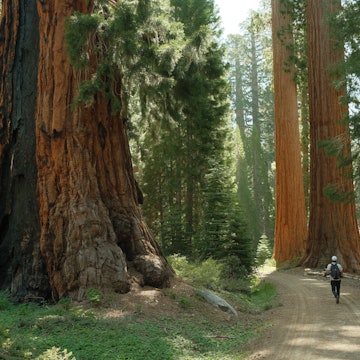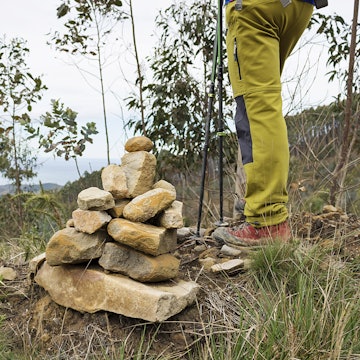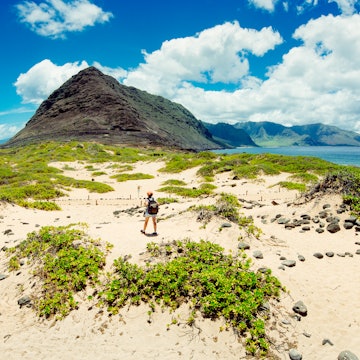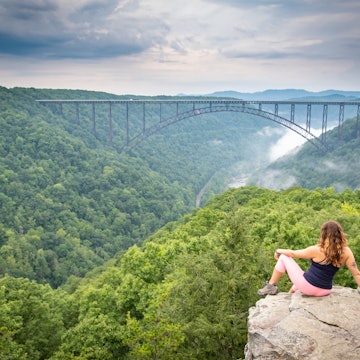

Hawaiʻi Volcanoes National Park is home to the world's largest volcano © Willyam Bradberry / Shutterstock
The island of Hawaiʻi, nicknamed the Big Island, is both the largest and youngest island in the Hawaiian archipelago, and it owes its size and age – to say nothing of its deepest cultural bedrock and even very existence – to its iconic volcanoes.
The soil of the Big Island is laced with minerals uplifted from the earth via volcanic activity, and the dirt incubates the island’s agricultural bounty. Its world-famous beaches are white and sometimes scattered with black volcanic sand, while the coast was formed by a ballet duet danced between the ocean and spewing lava.

The mana of magma in Hawaiʻi
The Hawaiian culture has always detected a rich vein of mana – admittedly reductively explained as "vital energy," but there's no good English translation of this Polynesian concept – that infuses the island. This life force is omnipresent and fierce, and it manifests in everything from the surreal overgrowth jungle of Puna to the indigo and ocher desert intensity of the Kohala Coast.
And yet we cannot consider the raw creative power of lava without acknowledging its destructive potential. The volcanic energy of the island of Hawaiʻi creates life, but it can also manifest itself in lava flows that destroy homes, shut down roads and, if approached too closely, threaten bodily harm. The sheer power of Hawaiʻi’s volcanism is something to be fascinated by, but it also deserves solemn respect. Indeed, federal, state and local authorities exercise and advise a degree of circumspection at the island’s main volcano sites, such as in Hawaiʻi Volcanoes National Park.

Natural wonders of the Big Island
The landscape of the island of Hawaiʻi takes form in the great vine-laced forests of Puna and Kaʻū and the emerald valleys of the Hāmākua Coast. But it also manifests in the sunburned deserts of the Kohala Coast, studded with a moonscape of lava rock fields and dusty yellow grass. All of this land is the byproduct of volcanic activity, and that activity stems from five of the island’s most recognizable features: the shield volcanoes of Maunakea, Maunaloa, Hualālai, Kohala and Kīlauea.
Pele, the Polynesian deity of fire and creation, is said to live in Kīlauea’s Halemaʻumaʻu crater, which was dramatically reshaped by lava activity in lower Puna in 2018. Pele is capricious and creative, and this dual capacity to both burn a home and leave the dark lava that the island grows out of is still in her. A good way to honor Pele is to visit and marvel at her volcanic home, which is the centerpiece of Hawaiʻi Volcanoes National Park. Halemaʻumaʻu crater, Pele’s home, dramatically expanded in size and depth, and in doing so, destroyed the old overlook parking area.
You can still see wide swaths of the moonscape ash and stone uplands that make up the park’s unique landscape. Chain of Craters Road winds 20 miles and 3700ft down the southern slopes of Kilauea Volcano, ending abruptly at the East Rift Zone on the Puna Coast. Along the Sulphur Banks Trail, a wooden boardwalk weaves between misty, rocky vents stained chartreuse, yellow, orange and other psychedelic colors by tons of sulfur-infused steam rising from deep within the earth. Nearby is an artists' colony known as Volcano; many of the artists who live here claim direct inspiration from Pele herself.

Valleys of the Kings
Like furrows dug by the fingers of a great Polynesian deity, a series of erosional valleys claw out the northeastern coast of the island of Hawaiʻi. Two of these, Pololū Valley and Waipiʻo Valley, can be viewed from their lookouts. Both valleys were, and still are, vital to the culture of past and present Native Hawaiians. Their fecund soil is a byproduct of volcanic activity, and from this dark dirt grew great fields of kalo (taro), which were foundational to Polynesian culture and caloric intake. It was this boundless fertility, to say nothing of the valley’s natural defensibility, that led to Waipiʻo’s position as capital and seat of power of Hawaiʻi’s early aliʻi (kings).
The sheer energy that seems to emanate from the valleys can be traced to the island’s volcanoes, and this power, to some, still has magical, mystical connotations. Even today, the valleys are said to be home to the island’s menehune, a magical race of little people of Hawaiian legend. While the slopes of Hualālai volcano, which overlooks Kona, do not have the royal associations of Pololū and Waipiʻo, they share the same fertile volcanic soil. The high mineral concentrations embedded in the jungly dirt of South Kona feed the coffee harvest of the island of Hawaiʻi. The Kona-grown coffee, perhaps this island’s iconic agricultural product, owes its existence to local volcanoes.

Landscape of lava
The dry zone of the Kohala Coast is hot. This is not the jungle tropical paradise you may imagine when you think of Hawaii; this is a lava desert riven with great veins of lava rock, the evidence of previous lava flows. Lava is divided into two camps: pāhoehoe and ʻaʻā. Pāhoehoe lava pours in thick, liquid ropes, drying into the same ripples and folds like a bar of melted chocolate. It is smooth to walk on, and in direct sun, the black rock breaks the light into pinpoint silicate rainbows.
In some ways, all you need to know about ʻaʻā lava (pronounced "ah-ahh") is its name. The joke goes the Hawaiians named the rock for the sound one makes when it is stepped on. ʻAʻā lava is full of gas bubbles, and when the liquid cools into rock, the result is a light, yet painfully spiny stone that is more fun to admire from afar than next to.
Lonely Planet has produced this article for The Hawaiian Islands. All editorial views are those of Lonely Planet alone and reflect our policy of editorial independence and impartiality.
This article was originally published in October 2018.
















